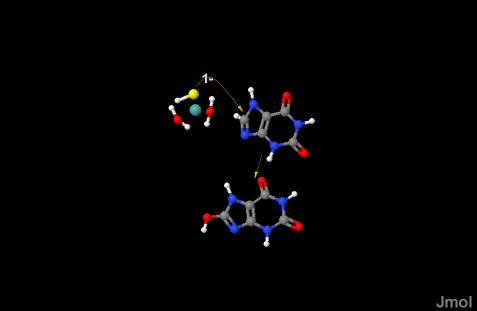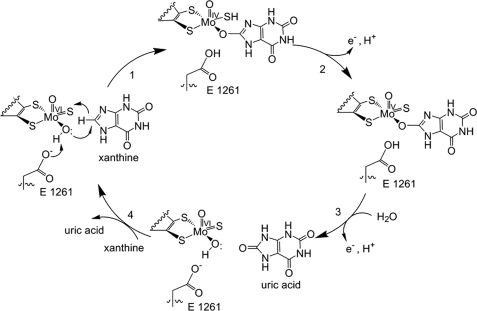Josie N. Harmon/Sandbox Tutorial
From Proteopedia
(Difference between revisions)
| (13 intermediate revisions not shown.) | |||
| Line 25: | Line 25: | ||
== Clinical Application == | == Clinical Application == | ||
| - | Xanthine oxidase <scene name='Josie_N._Harmon/Sandbox_Tutorial/Inhibitor/2'>inhibitors</scene> act by inhibiting the activity of the enzyme, namely its purine metabolism activity. Inhibitors of the enzyme are commonly used in the treatment of hyperuricemia, and its corresponding medical conditions such as gout, by reducing the production of uric acid. | + | Xanthine oxidase <scene name='Josie_N._Harmon/Sandbox_Tutorial/Inhibitor/2'>inhibitors</scene> act by inhibiting the activity of the enzyme, namely its purine metabolism activity. Inhibitors of the enzyme are commonly used in the treatment of hyperuricemia, and its corresponding medical conditions such as gout, by reducing the production of uric acid. As previously mentioned xanthine oxidase plays an important role in purine degradation with the last step in this process resulting in the production of uric acid to be excreted from the body. This excretion; however, is not always an efficient process and there can be an abnormal accumulation of uric acid in the blood. This accumulation can come as a result of increased production by the way of a purine rich diet, decreased excretion by the way of drug interactions or genetics, or a combination of the two. The most common type of xanthine oxidase inhibitors are classified as purine analogues and consists of allopurinol and febuxostat. Currently there is also investigation of the use of xanthine oxidase inhibitors in the prevention and treatment of cardiovascular and cerebrovascular disease. |
| - | + | ||
</StructureSection> | </StructureSection> | ||
| + | |||
| + | <references/> | ||
| + | <ref group="xtra">PMID: 20615869</ref><ref group="xtra">PMID: 11005854</ref><ref group="xtra">Goodsell, David. Xanthine Oxidoreductase. 2009 Sept. DOI: 10.2210/rcsb_pdb/mom_2009_9</ref><ref group="xtra">Hille, R., Nishino, T., Bittner, F. Molybdenum enzymes in higher organisms. Coordination Chemistry Reviews. 2011 May;255(9-10):1179-1205. DOI: 10.1016/j.ccr.2010.11.034</ref><references group="xtra"/> | ||
Current revision
Xanthine Oxidase Biochemistry Tutorial
The purpose of this tutorial is to explain the mechanism of the metabolic enzyme xanthine oxidoreductase.
| |||||||||||
- Cao H, Pauff JM, Hille R. Substrate orientation and catalytic specificity in the action of xanthine oxidase: the sequential hydroxylation of hypoxanthine to uric acid. J Biol Chem. 2010 Sep 3;285(36):28044-53. Epub 2010 Jul 8. PMID:20615869 doi:10.1074/jbc.M110.128561
- Enroth C, Eger BT, Okamoto K, Nishino T, Nishino T, Pai EF. Crystal structures of bovine milk xanthine dehydrogenase and xanthine oxidase: structure-based mechanism of conversion. Proc Natl Acad Sci U S A. 2000 Sep 26;97(20):10723-8. PMID:11005854
- Goodsell, David. Xanthine Oxidoreductase. 2009 Sept. DOI: 10.2210/rcsb_pdb/mom_2009_9
- Hille, R., Nishino, T., Bittner, F. Molybdenum enzymes in higher organisms. Coordination Chemistry Reviews. 2011 May;255(9-10):1179-1205. DOI: 10.1016/j.ccr.2010.11.034



